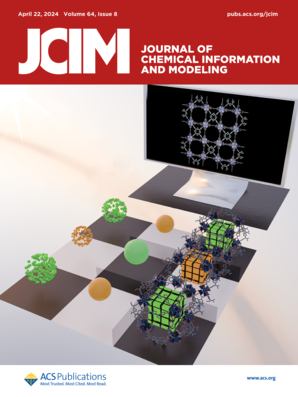基于分支定界法的分子组合高效叠加聚类算法。
IF 5.6
2区 化学
Q1 CHEMISTRY, MEDICINAL
引用次数: 0
摘要
均方根偏差(RMSD)是比较三维化学结构相似性最常用的度量之一。化学结构相似性在数据化学中起着重要的作用,因为它与化学反应性、物理性质和生物活性密切相关。尽管RMSD具有广泛的适用性,但同时确定RMSD的原子映射和空间叠加仍然是一个具有挑战性的问题,需要在多项式时间内解决。本文介绍了一种称为mobbRMSD的算法,该算法在分子定向坐标系中表达,并使用分支定界法获得RMSD的精确解。mobbRMSD可以有效地处理各种化学系统,如分子液体、溶质溶剂和大分子的自组装,利用化学知识,如原子类型、化学键和手性。在涉及小分子聚集体的基准测试中,mobbRMSD将现有精确解方法的极限系统大小扩展了近两倍。此外,mobbRMSD展示了分析大分子胶束结构相似性的能力,这是以前的方法所难以做到的。我们还提出了一种针对分子动力学轨迹的基于mobbrmsd的结构聚类方法,该方法改进了分支定界方法的计算成本,使多项式时间随着数据数量的增加而渐近平均。我们的算法可以在https://github.com/yymmt742/mobbrmsd上免费获得。本文章由计算机程序翻译,如有差异,请以英文原文为准。
Algorithm for Efficient Superposition and Clustering of Molecular Assemblies Using the Branch-and-Bound Method.
The root-mean-square deviation (RMSD) is one of the most common metrics for comparing the similarity of three-dimensional chemical structures. The chemical structure similarity plays an important role in data chemistry because it is closely related to chemical reactivity, physical properties, and bioactivity. Despite the wide applicability of the RMSD, the simultaneous determination of atom mapping and spatial superposition of RMSD remains a challenging problem to solve in polynomial time. We introduce an algorithm called mobbRMSD, which is formulated in molecular-oriented coordinates and uses the branch-and-bound method to obtain an exact solution for the RMSD. mobbRMSD can efficiently handle a wide range of chemical systems, such as molecular liquids, solute solvations, and self-assembly of large molecules, using chemical knowledge such as atom types, chemical bonding, and chirality. In benchmarks involving small molecular aggregates, mobbRMSD extends the limiting system size of existing exact solution methods by almost twice. Furthermore, mobbRMSD demonstrated the ability to analyze the structural similarity of large molecular micelles, which has been difficult with previous methods. We also propose a mobbRMSD-based structural clustering method designed for molecular dynamics trajectories, which improves the computational cost of branch-and-bound methods to asymptotically average the polynomial time as the number of data increases. Our algorithm is freely available at https://github.com/yymmt742/mobbrmsd.
求助全文
通过发布文献求助,成功后即可免费获取论文全文。
去求助
来源期刊
CiteScore
9.80
自引率
10.70%
发文量
529
审稿时长
1.4 months
期刊介绍:
The Journal of Chemical Information and Modeling publishes papers reporting new methodology and/or important applications in the fields of chemical informatics and molecular modeling. Specific topics include the representation and computer-based searching of chemical databases, molecular modeling, computer-aided molecular design of new materials, catalysts, or ligands, development of new computational methods or efficient algorithms for chemical software, and biopharmaceutical chemistry including analyses of biological activity and other issues related to drug discovery.
Astute chemists, computer scientists, and information specialists look to this monthly’s insightful research studies, programming innovations, and software reviews to keep current with advances in this integral, multidisciplinary field.
As a subscriber you’ll stay abreast of database search systems, use of graph theory in chemical problems, substructure search systems, pattern recognition and clustering, analysis of chemical and physical data, molecular modeling, graphics and natural language interfaces, bibliometric and citation analysis, and synthesis design and reactions databases.

 求助内容:
求助内容: 应助结果提醒方式:
应助结果提醒方式:


